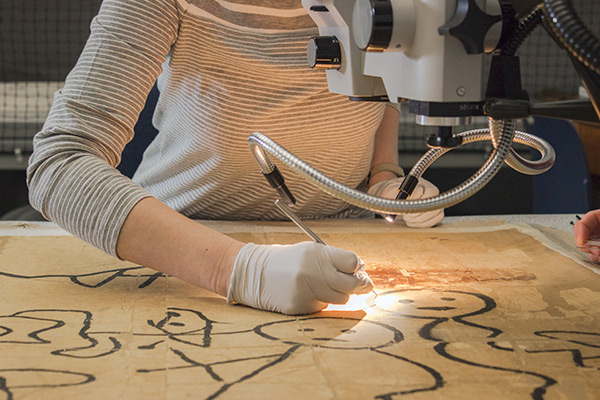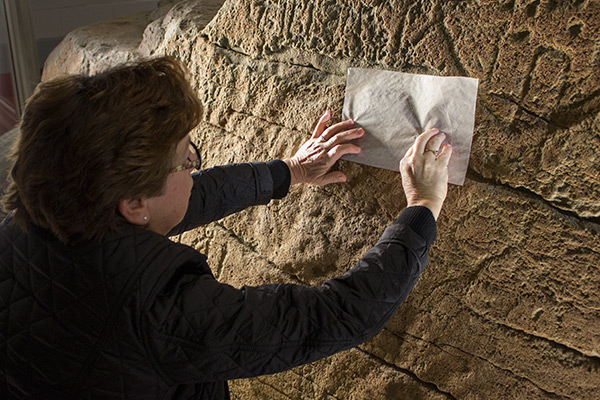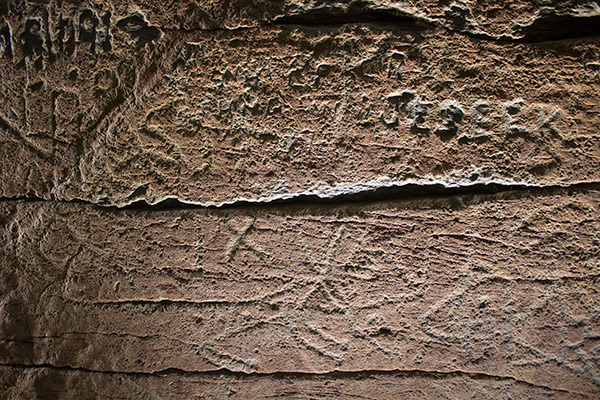In September 1768, Harvard professor Stephen Sewall visited the landmark known as “Dighton Rock,” an 11-foot boulder just off the coast of present-day Berkley, Massachusetts. He was there to copy inscriptions that Native Americans had carved into the rock years before.
Sewall brought his oversized work on paper back to Harvard, where it was installed just outside the Philosophy Chamber, a room that from 1766 until 1820 showcased major works of art, elaborate scientific instruments, artifacts and natural specimens, and an assortment of other curiosities from near and far. At some point after the Philosophy Chamber was dismantled, the drawing was added to the collection of Harvard’s Peabody Museum of Archaeology and Ethnology, where it remains today.
Besides those few facts, we don’t know much more about the work, including how it was made. Did Sewall visit Dighton Rock and re-create the tracings from memory, or did he work directly from the rock (which would have been partially covered at high tide), “chalking” the inscriptions and applying pressure to transfer them to paper? Did he put ink on his fingers and “trace” the inscriptions? And what materials did he use?
The work has been studied and conserved at just a few points in its lifetime. Now it is being examined by conservators from the Peabody Museum and the Straus Center for Conservation and Technical Studies, as the Harvard Art Museums prepare to include it in the upcoming exhibition The Philosophy Chamber: Art and Science in Harvard's Teaching Cabinet, 1766–1820, set to open in May 2017.
“We are trying to understand how this was made and the different materials used so that we can conserve it appropriately in the future,” said Lola Sanchez-Jauregui, the museums’ Maher Curatorial Fellow in American Art. “It also helps us better understand how to hang it in the exhibition.” Sanchez-Jauregui is assisting Ethan Lasser, the Theodore E. Stebbins Jr. Curator of American Art, in organizing the Philosophy Chamber exhibition.
Learning more about the object’s history also contributes to the body of knowledge presented in the exhibition. As our chronicle of the exhibition’s development attests, many aspects of the 18th-century room remain unknown, and research is ongoing.
Investigating the Inscriptions
It was an unseasonably chilly, gray day in May when a small group from the Harvard Art Museums and the Peabody Museum visited the Dighton Rock Museum, where the rock is currently housed. Anne Driesse, a paper conservator in the Straus Center who attended the visit, is leading the material examination of Sewall’s work. Armed with tracings from the work, Driesse hoped to match them up with the rock’s inscriptions. “That might get us closer to determining how the drawing was made,” she said.
She crouched next to the rock and placed the first tracing—curved lines—on an area with the same design, running her fingers over the inscription. “It’s slightly off, but pretty close,” she said. She found the same result with another segment.
A third portion she attempted to find, however—a carving that looks like a W merged with a V—was nowhere to be found. Pointing to an area where a chunk of the rock seemed missing, she observed that damages (due to both human and natural causes) could prevent anyone today from ever fully appreciating the complete set of carvings.
New Ideas
Back in Cambridge, Driesse admitted she had been surprised to find that the rock’s inscriptions fit so neatly with Sewall’s tracings. “I’m more convinced now that he made this directly from the rock,” Driesse said. Though she stressed her ideas were only conjecture, she said it was possible Sewall brought several large sheets of paper to the rock, and took an impression using ink. Later, he may have cut and joined them, reinforcing the characters and lining the sheets with cloth for display purposes. (Pasting paper to canvas was a common practice at the time.)
Although investigating artistic processes and examining an object’s condition is standard for a conservator, this project represents something new for Driesse. Sewall’s drawing is “unlike any object we have in the museums’ collections,” she said. She plans to return soon for another close look at the rock, and will publish her findings in the catalogue that accompanies the Philosophy Chamber exhibition.
In the meantime, Driesse’s Straus Center colleagues are examining the materials in Sewall’s work. Georgina Rayner, the Andrew W. Mellon Postdoctoral Fellow in Conservation Science, is conducting a fiber analysis to determine the type of paper Sewall used. Her methods, including polarized light microscopy (PLM), will help researchers understand the paper’s origins. Rayner will also study the ink’s pigment and binder using specialized equipment. “Knowing the paint makeup may tell us more about the object’s conservation history,” Driesse said.
Even if some questions are answered by this 21st-century detective work, many more will undoubtedly persist or even emerge with the new findings. What remains clear is that Sewall’s drawing will continue to prompt spirited debate, both in the context of the Philosophy Chamber exhibition and beyond.




